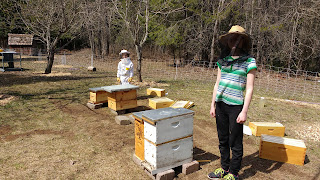MissB and MisterA each grabbed a box of frames, just in case, and headed to the apiary. Neither of the hives needed more equipment, but I want them to learn to be prepared.
MisterA's hive (the far one in the photo) has a nuc feeder on top; one of those pans with a cage to hold the bees out of the syrup - I'll do a closeup in another post. The rest of the hives have a box with a feeder tucked into it. The close two have inverted jars of syrup, which they gobble down fast! I hope their not just leaking! The last feeder is more like an inverted tube cake pan with a passage in the center for the bees. I have one on my big hive, too.
The new beekeepers were a little intimidated with the tiny cork in the queen cage. I had them smoke their hives and open them up, but they asked me to swap the marshmallow in for the cork. Now, we'll wait at least a week to check for ba-bees: eggs, larva, maybe even capped brood. Actually, it's supposed to rain all next week, from what I can tell, so it may be more like ten days.
(The other hive has been removed and the bees allowed to choose one of the other hives to join because I thought my big hive may have gone queenless, and she's been moved).
MissB's bees are on the right. You can see the top entrance in the inner covers on both these hives. We had a stick in front of MissB's lower entrance originally, too, but exchanged it for an entrance reducer. The bottom board is the short way up, so we'll have to flip it to fit the reducer in properly.
The Italians (in the left hive) seem a bit more aggressive than the rest of my bees. The rest are Carniolans. They bump against me and fly up in my face more than the others. The Italians are reputed to build up faster, sometimes to their own demise, and store more honey per capita than the other breeds. The Carniolans are recommended for the north because they seem to only lay as much brood as they can care for, so are slower to build up, which helps conserve stores as well.



No comments:
Post a Comment